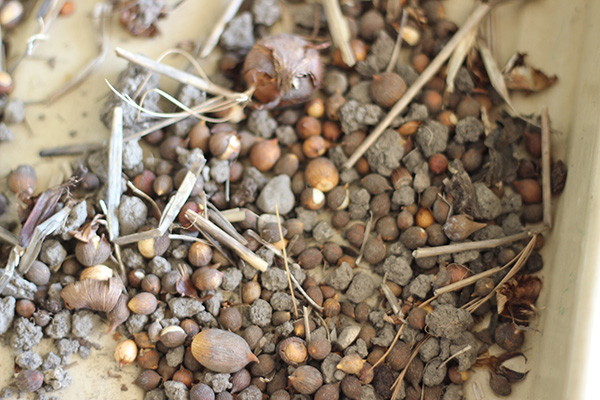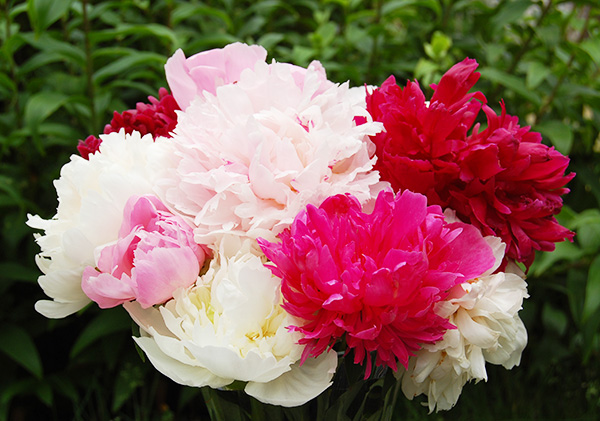To read more by topic or date, see our Newsletter Archives page.
May 30, 2023
“May. — The very word makes the heart leap. Birds, Buds, Blossoms, Beauty! Break away from every bondage of circumstance or low spirits and go out into the sunshine. Answer back the bird-note in your heart, kiss your finger tips to every new blossom, and be a part of the spring.”
— Eva D. Kellogg, “May,” 1902
Order Iris and Daylilies Now for July Planting!

|

|

|

|

|

|
We're kicking off summer by offering July-shipped iris and daylilies! If spring comes too late to plant iris in April or we sold out of your favorite variety this spring, this is your chance to add them to your garden. We’ll be accepting orders through July 15th and shipping July 10th-28th. The rhizomes will be fresh-dug and eager to go into the ground.
Hurrah for May in Michigan!
May is a beautiful month here in Michigan with new foliage in so many shades of green and tulips giving way to iris followed by peonies for Memorial Day. We hope you’ve found beauty and rejuvenation in your garden this spring as well and that you had great success with our fall-planted bulbs! (On the off-chance, however, that something disappointed, please let us know - we like to trouble-shoot before spring has become just a distant memory.) And please join us in celebrating our multi-talented IT guru Justin Hunt who (in addition to being a great dad) just graduated his nursing program, passed the NCLEX, and is now a licensed RN!
Newly Available for Fall Shipping: 4 Daffodils, Plus a Galanthus and Dutch Iris
We’re excited to have found sources for 6 historic varieties that we’re now able to offer for the first time. In approximate order of their bloom times, we are happy to present
Galanthus woronowii, commonly called Green Snowdrops for their glossy leaves that delightfully interrupt the bleak or snowy landscape of earliest spring. The gently swaying bell-shaped flowers are unfazed by chilly breezes and are a welcome sign that the end of winter is on its way!
Award-winning daffodil ‘Merlin’ whose glowing red-rimmed yellow hearts in pure-white blossoms are sure to catch your eye. Simply stunning!
‘Dawn’, another wonderful creation of the great daffodil breeder Rev. George Engleheart, who brought us ‘Will Scarlett’ and ‘Firebrand’. Petite and charming with several blossoms to a stem.
Charming ‘Sweet Harmony’ which brings an eye-catching combination of a bright white and yellow trumpet against a creamy white perianth. With large blooms and sturdy stems, it is striking both in the garden or bouquets.
‘Rosy Trumpet’, a creation of Mr. R. O. Backhouse who introduced the first “pink” daffodils in the 1920s. This diminutive variety has a starry white perianth around a long apricot trumpet and makes a lovely little sister to ‘Romance’ and ‘Louise de Coligny’.
‘Sapphire Beauty’, a 2’ tall Dutch iris that welcomes summer with bright purplish-blue blossoms highlighted by bright yellow flames. Elegant, lovely, and low-maintenance!
Glads for Free – Tips for Growing Your Tiny Cormlets into Big Fat Corms

|
If you dug and stored your gladiolus last fall, you probably found lots of tiny cormlets – aka cormels – clustered around their bases. Plant the largest of those this spring and before long you’ll have more blooming-sized glads for free. Cliff Hartline in the NAGC’s Glad World offers these expert tips:
“Generally speaking, any cormel that falls through a 1/8-inch screen does not produce well. . . . I only plant cormels the size of a pencil eraser or larger. I pass all my cormels over a 1/4-inch screen and plant those that do not fall through. . . . . The larger ones will definitely give you a larger corm to harvest and . . . if they are planted early, they will often bloom in September. . . .
“One year after I finished digging my large corms about September 20, I had the time to dig my glads from cormels. After pulling a few out of the ground, I saw that the corms were the size of a quarter or smaller. I decided to foliar feed them, and I applied fungicide at the same time. We had a frost October 15 so I dug them immediately after that. Many of the corms were jumbos, most were large, and very few were smaller. Iwould encourage people to wait until frost to dig cormel stock, and foliar feed late in the year. . . . The September feeding seemed to rejuvenate the growth and the fungicide kept the foliage healthy.”
We’ll remind you that cormlets have nearly impenetrable outer shells and they’ll sprout much better if you either nick or gently crack these or simply dissolve them by soaking in full-strength household bleach for a few hours immediately before planting. Plant cormlets in full sun, 1-2 inches deep and 1-2 inches apart, depending on size. Keep the soil moist but not soggy until grass-like foliage emerges and, for optimal growth, throughout the summer. Good luck, have fun, and let us know how they do for you!
How to Make Your Peony Bouquets Last Longer

|
Lush and romantic, peonies are fabulous in bouquets. To get the most out of yours, here are some tips from Dr. Patricia Holloway of the University of Alaska, as quoted by Debra Prinzing in her book Slow Flowers:
“‘Cut peonies during the coolest part of the day. Cut once you see the true color of the flower with one or two petals separating at the top [the “soft marshmallow” stage] – or any time after that. Then the flower will continue to open in your arrangement.” If you cut prior to this stage the buds either will not open or they will be stunted. Fully-opened blooms can also be harvested, but their vase life is shorter.
“Dr. Holloway also offers this commercial growers’ tip; ‘Once cut, your flowers should be chilled in the refrigerator for at least 24 hours and up to one week before putting them into a vase. That chilling very definitely extends vase life.’ Wrap the peonies in paper towels and lay them flat in the crisper drawer, away from the refrigerator’s other contents.”
We’ll also remind you that for future growth and bloom it’s best to leave as much foliage as possible on the plant. This is especially important during the first two years after planting, and in fact many experts recommend that you cut NO flowers the first year. We know how hard that can be, but your patience will be rewarded.
Our growers have not confirmed varieties available for us this fall. Please stay tuned, we should know soon what is available and will announce it in an upcoming newsletter.
Share Our Gazette with a Friend
Please help us “Save the Bulbs!” by forwarding our newsletter to a kindred spirit, garden, museum, or group.
To Reprint Any Part of Our Gazette . . .
Simply credit www.oldhousegardens.com.











